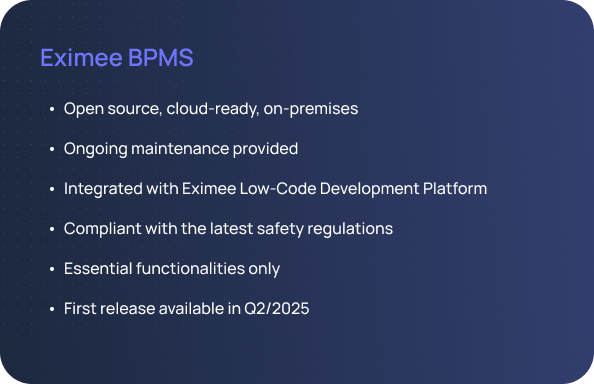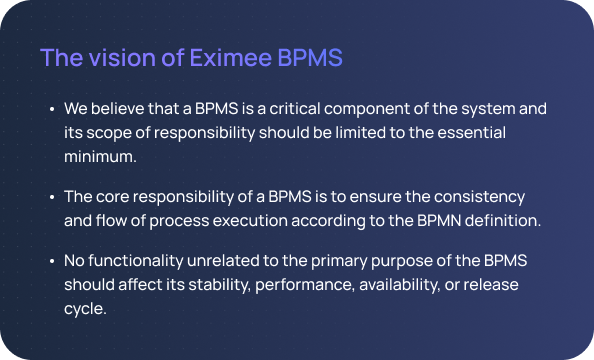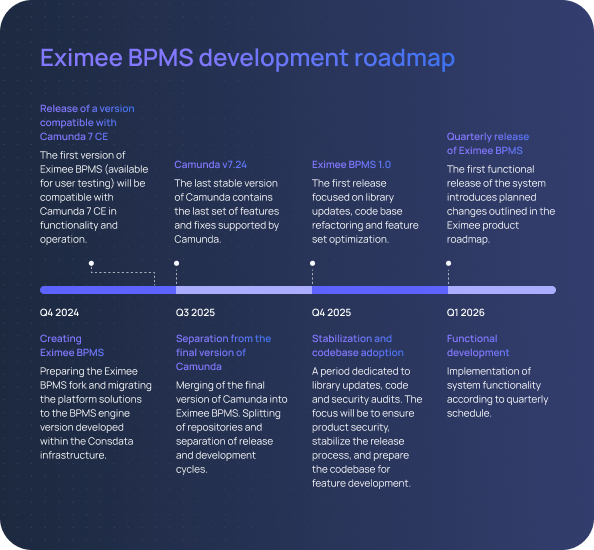
In 2025, the final version of Camunda 7 Community Edition will be released, and migrating to a newer version is not an obvious choice as it involves significant architectural changes. Users who value Camunda 7 CE for its comprehensive BPMN 2.0 implementation and the ability to integrate the engine into their own applications can now rely on a new stable fork – EximeeBPMS.
According to Camunda’s official announcement, the provider will release the final version of the Community Edition (v7.24) in October 2025 and stop further development of this edition. What does this mean? After this date there will be no more releases of Camunda 7 CE and the Camunda repositories will be archived and marked as “deprecated". No further enhancements or fixes will be committed to the repository – feature development will end. Importantly, no security-related patches or updates will be introduced.
Business Process Management (BPM) is a holistic approach to managing and improving an organization’s business processes. It involves the systematic identification, design, execution, monitoring, and continuous improvement of business processes to achieve organizational goals and objectives. BPM aims to increase efficiency, reduce costs, and enhance customer satisfaction by streamlining and automating business processes. By focusing on process management, organizations can ensure that their operations are aligned with their strategic goals, leading to better performance and competitive advantage. Continuous improvement is a core principle of BPM, encouraging organizations to regularly review and refine their processes to adapt to changing market conditions and customer needs.
The most obvious solution is to migrate to the newer version – Camunda 8. However, this option comes with significant limitations. Camunda 8 fundamentally changes the system architecture, reduces available functionality and integration options, and introduces a licensing policy that restricts access to key features. For organizations, this represents a major technology shift that requires the migration of existing processes.
Alternatively, users can pay for extended support and security updates under the Camunda 7 Enterprise Edition. However, this is only a temporary solution that allows users to continue using the platform for only four more years.
A third alternative is to migrate to another business process management software such as jBPM, Activiti, Flowable or Kogito. Regardless of the chosen tool, this would require costly adjustments to align existing processes with the new engine and reintegrate business applications with it. It is important to note that while these tools have been on the market for some time, they have not been the preferred choice for companies that have previously relied on Camunda.
At Consdata we are successfully working with Camunda 7, which we are seamlessly integrating with our low-code platform Eximee. Considering the drawbacks of the solutions mentioned above, we have been preparing for various scenarios for quite some time. We have also taken into account the needs and concerns of our customers, as well as changes in the market. At the moment, the most advantageous scenario for our customers seems to be the creation of our own solution.
That is why we decided to develop EximeeBPMS – a BPMS engine based on the latest stable version of Camunda. EximeeBPMS addresses the market needs of companies that have been using Camunda 7, do not plan to migrate to Camunda 8, and want to avoid costly migration to another BPMS tool. By leveraging EximeeBPMS, companies can optimize their business processes. Additionally, it allows them to automate business processes, enhancing organizational agility.
Maciej Ulaszewski, co-founder of Consdata, points out:
“For many years we have been working with various BPMS engines, including those that come from jBPM and Activiti. This experience has given us a deep insight into the strengths and weaknesses of these tools. We believe that our expertise will allow us to further develop the best features of Camunda 7 in the form of the new EximeeBPMS engine".

EximeeBPMS is an open source, on-premises and cloud-ready solution. Based on our experience with Camunda 7, we have tailored the features of the EximeeBPMS engine to meet the needs of users and business cases that we continuously address using the Eximee Low-Code Platform. It enables users to automate complex tasks, and also to automate complex processes through graphical representations for better clarity and visibility.
As Consdata, we focus on the stable development of EximeeBPMS through evolution, ensuring compatibility in key areas and streamlining the engine’s codebase. This powerful system supports the ability to manage business processes at every stage, including modeling, executing, and adapting processes in dynamic environments. While EximeeBPMS is offered as an open source solution, we also plan to introduce support services that will be available as part of a paid service.
Effective complexity and performance management
In EximeeBPMS, we focus on separating engine functionalities according to the CQRS architecture (independent handling of queries and operations), which allows effective management of the architecture’s complexity and performance. Business process management tools can be classified as either closed-source or open-source software, with closed-source tools offering dedicated support and restricted access to source code, while open-source tools provide flexibility and adaptability for businesses. This approach ensures that EximeeBPMS integrates seamlessly with our Eximee Low-Code Development Platform, as well as with other systems built using the CQRS pattern.
Only essential functionality
EximeeBPMS is focused on features that really address user needs, so we plan to streamline the engine codebase to the minimum necessary to handle process-related functionalities.
Dedicated components
All elements that are not critical to the consistency and correctness of BPMN definitions, as well as read operations, can be implemented as dedicated domain components based on event stream projections.
Task execution in separate microservices
EximeeBPMS acts as a task provider, while the execution of tasks is performed in separate microservices. This is an extension of the “External Task Pattern" promoted by Camunda, which is perfectly aligned with the architecture of the Eximee platform.
Cloud ready
EximeeBPMS will be deployable as a PaaS in cloud infrastructure.
Security focused
EximeeBPMS will be developed according to Consdata’s standards for building electronic banking applications. This ensures a development process that meets the highest security requirements and guarantees continuity of product development.

It is also important to note that the EximeeBPMS engine is fully developed and maintained by Consdata, a company with over 10 years of experience in developing systems based on leading BPMS solutions.
During this time, we have successfully developed another open source solution: Kouncil – a graphical interface for Apache Kafka with advanced monitoring capabilities. Kouncil is used worldwide, mainly by banks. Whether it’s Kouncil or other products, our approach focuses on addressing customer needs and applying best practices, prioritizing key functional elements that deliver real value.
Our vision for the development of EximeeBPMS is based on practical production experience, including required functionalities, integrations, adaptation of existing BPMS solutions and identification of key limitations in the current development direction of Camunda. We believe that it is technologically possible to evolve and extend a BPMS built on the Activiti/Camunda foundation without breaking backward compatibility or rewriting the solution from scratch.
The first official release of EximeeBPMS is scheduled for Q2 2025, ensuring that users will have access to the full capabilities of EximeeBPMS in a stable and secure manner at the end of the Camunda 7 lifecycle.

Although the official end of development for Camunda 7 is planned for next year, organisations should already be evaluating their options for migrating to a replacement tool. Key decision factors will undoubtedly include stability, security, performance and the ease of adapting existing applications to the new engine. With these factors in mind, EximeeBPMS is certainly a solution worth considering for any institution that wants to remain competitive in the modern business environment.
Find out how EximeeBPMS can help you – book a meeting
Powered by Consdata
hello@eximeebpms.org
+48 614 151 000
Consdata S.A.
Krysiewicza 9/14
61-825 Poznań
Poland